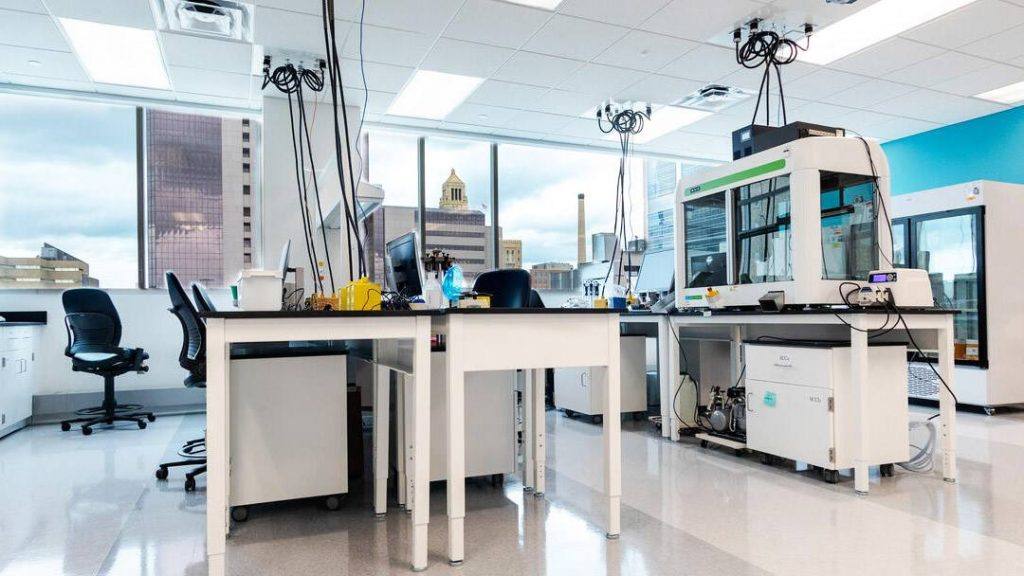
The Advanced Diagnostics Laboratory (ADL) is a visionary space designed to continue Mayo Clinic’s long tradition of pioneering patient treatments and diagnostics. The ADL’s mission is to foster innovation — including grassroots innovation — across different specialties, through partnerships in-house as well as with external companies. Located on the third floor of One Discovery Square in a 9,600-square-foot space, the lab was born out of an initiative between Mayo’s Department of Laboratory Medicine and Pathology (DLMP) and the Center for Individualized Medicine (CIM).
“New disruptive technologies and industry collaborations are keys to our success in innovation,” says Kathy Bates, senior director of Laboratory Services and Partnership Development in DLMP and administrator of the ADL. “This space has room and resources for evaluating technology quickly, enabling us early access to technology and the opportunity to test it, with the potential to influence the final product. These resources allow us to strike more business agreements and co-development relationships, move quickly, and bring more capabilities to the collaboration.”
Co-development agreements have already been struck with, for example, Numares, a German-based company that is leveraging nuclear magnetic resonance (NMR) technology, using AI to quantify “metabolite constellations” and, thus, help patients with undiagnosed diseases or conditions; Breath Diagnostics, a medical device company in Kentucky that is developing a test to detect lung cancer using patients’ exhaled breath; and more recently, Thermo Fisher Scientific.
“Thermo Fisher is a very innovative, large diagnostic company that DLMP has worked with for a number of years,” says Bates. “The challenges of the COVID pandemic really strengthened our relationship. So we recently executed an updated agreement with Thermo Fisher to focus on innovation and develop novel tests on three of their technology platforms — next-generation sequencing (NGS), mass spectrometry, and allergy and autoimmunity diagnostic tools.”
The collaboration is part of Mayo Clinic’s movement towards “precision medicine” and is aimed at advancing such diagnostics in a clinically relevant, globally accessible manner.
Benjamin Kipp, Ph.D., is director of the ADL. “I think a lot of these companies have really cool projects, but we have to push the boundaries, we have to know where they fail, and we have to know where they work so that we can implement them for our patients,” he says.
Flexibility fuels innovation
Designed as a “flexible” space, the ADL moves beyond a traditional lab model: it can be quickly modified to meet each project’s needs. It’s also a think tank, a fulcrum for new ideas — which is why its office area features entire walls of whiteboard to help capture ideas and cultivate discussion. The larger environment of One Discovery Square is a vibrant, collaborative atmosphere that encourages various companies, educators, and researchers to cross-pollinate ideas and innovation in diagnostic and biomedical technologies.
“We needed to create an environment that was more of a ‘sandbox,’ if you will — something that has more flexibility, which used to live within the clinical labs but really does not anymore,” says William Morice, II, M.D., Ph.D., chair of DLMP and president of Mayo Clinic Laboratories. “The ADL is really an attempt to try and bring these innovative technologies and some of these resources into an environment that’s more flexible so we can adapt to what the clinicians are asking of us.”
When the pandemic emerged last year, the lab’s nimble design allowed its staff of multidisciplinary experts to pivot their efforts to the crisis.
Read the rest of this article, written by Christopher Bahn, on the Mayo Clinic Laboratories site.
____________________________________________
Other Mayo Clinic medical research websites:
- Research at Mayo Clinic
- Discovery’s Edge
- Advancing the Science
- Forefront
- Mayo Clinic Center for Individualized Medicine
- Center for Regenerative Medicine
- Center for the Science of Health Care Delivery







